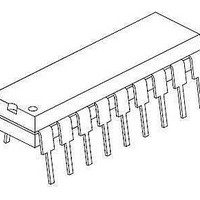PIC16LF1847-E/ML Microchip Technology, PIC16LF1847-E/ML Datasheet - Page 208

PIC16LF1847-E/ML
Manufacturer Part Number
PIC16LF1847-E/ML
Description
14 KB Flash, 1K Bytes RAM, 32 MHz Int. Osc, 16 I/0, Enhanced Mid Range Core, Nan
Manufacturer
Microchip Technology
Series
PIC® XLP™ mTouch™ 16Fr
Datasheet
1.PIC16F1847-EP.pdf
(408 pages)
Specifications of PIC16LF1847-E/ML
Core Processor
PIC
Core Size
8-Bit
Speed
32MHz
Connectivity
I²C, LIN, SPI, UART/USART
Peripherals
Brown-out Detect/Reset, POR, PWM, WDT
Number Of I /o
15
Program Memory Size
14KB (8K x 14)
Program Memory Type
FLASH
Eeprom Size
256 x 8
Ram Size
1K x 8
Voltage - Supply (vcc/vdd)
1.8 V ~ 3.6 V
Data Converters
A/D 12x10b
Oscillator Type
Internal
Operating Temperature
-40°C ~ 125°C
Package / Case
28-VQFN Exposed Pad
Core
PIC
Processor Series
PIC16LF
Data Bus Width
8 bit
Maximum Clock Frequency
32 MHz
Data Ram Size
256 B
Number Of Programmable I/os
15
Number Of Timers
ÿ4 x 8-bit, 1 x 16-bit
Operating Supply Voltage
1.8 V to 5.5 V
Mounting Style
Through Hole
Interface Type
SPI, I2C
Lead Free Status / Rohs Status
Lead free / RoHS Compliant
- Current page: 208 of 408
- Download datasheet (4Mb)
PIC16(L)F1847
24.2
The Compare mode function described in this section
is available and identical for CCP modules ECCP1,
ECCP2, CCP3 and CCP4.
Compare mode makes use of the 16-bit Timer1
resource. The 16-bit value of the CCPRxH:CCPRxL
register pair is constantly compared against the 16-bit
value of the TMR1H:TMR1L register pair. When a
match occurs, one of the following events can occur:
• Toggle the CCPx output
• Set the CCPx output
• Clear the CCPx output
• Generate a Special Event Trigger
• Generate a Software Interrupt
The action on the pin is based on the value of the
CCPxM<3:0> control bits of the CCPxCON register. At
the same time, the interrupt flag CCPxIF bit is set.
All Compare modes can generate an interrupt.
Figure 24-2
Compare operation.
FIGURE 24-2:
24.2.1
The user must configure the CCPx pin as an output by
clearing the associated TRIS bit.
Also, the CCPx pin function can be moved to
alternative pins using the APFCON register. Refer to
Section 12.1 “Alternate Pin Function”
details.
DS41453B-page 208
Note:
CCPx
Pin
Output Enable
TRIS
Compare Mode
CCP PIN CONFIGURATION
Clearing the CCPxCON register will force
the CCPx compare output latch to the
default low level. This is not the PORT I/O
data latch.
shows a simplified diagram of the
Q
Special Event Trigger
CCPxM<3:0>
R
S
Mode Select
Output
COMPARE MODE
OPERATION BLOCK
DIAGRAM
Logic
Set CCPxIF Interrupt Flag
4
(PIRx)
Match
CCPRxH CCPRxL
TMR1H
Comparator
for more
TMR1L
Preliminary
24.2.2
In Compare mode, Timer1 must be running in either Timer
mode or Synchronized Counter mode. The compare
operation may not work in Asynchronous Counter mode.
See
more information on configuring Timer1.
24.2.3
When Generate Software Interrupt mode is chosen
(CCPxM<3:0> = 1010), the CCPx module does not
assert control of the CCPx pin (see the CCPxCON
register).
24.2.4
When Special Event Trigger mode is chosen
(CCPxM<3:0> = 1011), the CCPx module does the
following:
• Resets Timer1
• Starts an ADC conversion if ADC is enabled
The CCPx module does not assert control of the CCPx
pin in this mode.
The Special Event Trigger output of the CCP occurs
immediately upon a match between the TMR1H,
TMR1L register pair and the CCPRxH, CCPRxL
register pair. The TMR1H, TMR1L register pair is not
reset until the next rising edge of the Timer1 clock. The
Special Event Trigger output starts an A/D conversion
(if the A/D module is enabled). This allows the
CCPRxH, CCPRxL register pair to effectively provide a
16-bit programmable period register for Timer1.
TABLE 24-3:
Refer to
more information.
Note:
Note 1: The Special Event Trigger from the CCP
Section 24.2.2 “Timer1 Mode Resource”
PIC16(L)F1847
2: Removing
Section 16.2.5 “Special Event Trigger”
Device
TIMER1 MODE RESOURCE
Clocking Timer1 from the system clock
(F
mode. In order for Compare mode to
recognize the trigger event on the CCPx
pin, TImer1 must be clocked from the
instruction clock (F
external clock source.
SOFTWARE INTERRUPT MODE
SPECIAL EVENT TRIGGER
module does not set interrupt flag bit
TMR1IF of the PIR1 register.
changing the contents of the CCPRxH
and CCPRxL register pair, between the
clock edge that generates the Special
Event Trigger and the clock edge that
generates
preclude the Reset from occurring.
OSC
) should not be used in Compare
SPECIAL EVENT TRIGGER
2011 Microchip Technology Inc.
the
the
match
Timer1
OSC
/4) or from an
CCPx
CCP4
condition
Reset,
will
by
for
for
Related parts for PIC16LF1847-E/ML
Image
Part Number
Description
Manufacturer
Datasheet
Request
R

Part Number:
Description:
IC, 8BIT MCU, PIC16LF, 32MHZ, QFN-28
Manufacturer:
Microchip Technology
Datasheet:

Part Number:
Description:
IC, 8BIT MCU, PIC16LF, 32MHZ, QFN-28
Manufacturer:
Microchip Technology
Datasheet:

Part Number:
Description:
IC, 8BIT MCU, PIC16LF, 32MHZ, DIP-18
Manufacturer:
Microchip Technology
Datasheet:

Part Number:
Description:
IC, 8BIT MCU, PIC16LF, 20MHZ, TQFP-44
Manufacturer:
Microchip Technology
Datasheet:

Part Number:
Description:
7 KB Flash, 384 Bytes RAM, 32 MHz Int. Osc, 16 I/0, Enhanced Mid Range Core, Nan
Manufacturer:
Microchip Technology

Part Number:
Description:
14KB Flash, 512B RAM, LCD, 11x10b ADC, EUSART, NanoWatt XLP 28 SOIC .300in T/R
Manufacturer:
Microchip Technology
Datasheet:

Part Number:
Description:
14KB Flash, 512B RAM, LCD, 11x10b ADC, EUSART, NanoWatt XLP 28 SSOP .209in T/R
Manufacturer:
Microchip Technology
Datasheet:

Part Number:
Description:
MCU PIC 14KB FLASH XLP 28-SSOP
Manufacturer:
Microchip Technology

Part Number:
Description:
MCU PIC 14KB FLASH XLP 28-SOIC
Manufacturer:
Microchip Technology

Part Number:
Description:
MCU PIC 512B FLASH XLP 28-UQFN
Manufacturer:
Microchip Technology

Part Number:
Description:
MCU PIC 14KB FLASH XLP 28-SPDIP
Manufacturer:
Microchip Technology

Part Number:
Description:
MCU 7KB FLASH 256B RAM 40-UQFN
Manufacturer:
Microchip Technology

Part Number:
Description:
MCU 7KB FLASH 256B RAM 44-TQFP
Manufacturer:
Microchip Technology

Part Number:
Description:
MCU 14KB FLASH 1KB RAM 28-UQFN
Manufacturer:
Microchip Technology

Part Number:
Description:
MCU PIC 14KB FLASH XLP 40-UQFN
Manufacturer:
Microchip Technology










